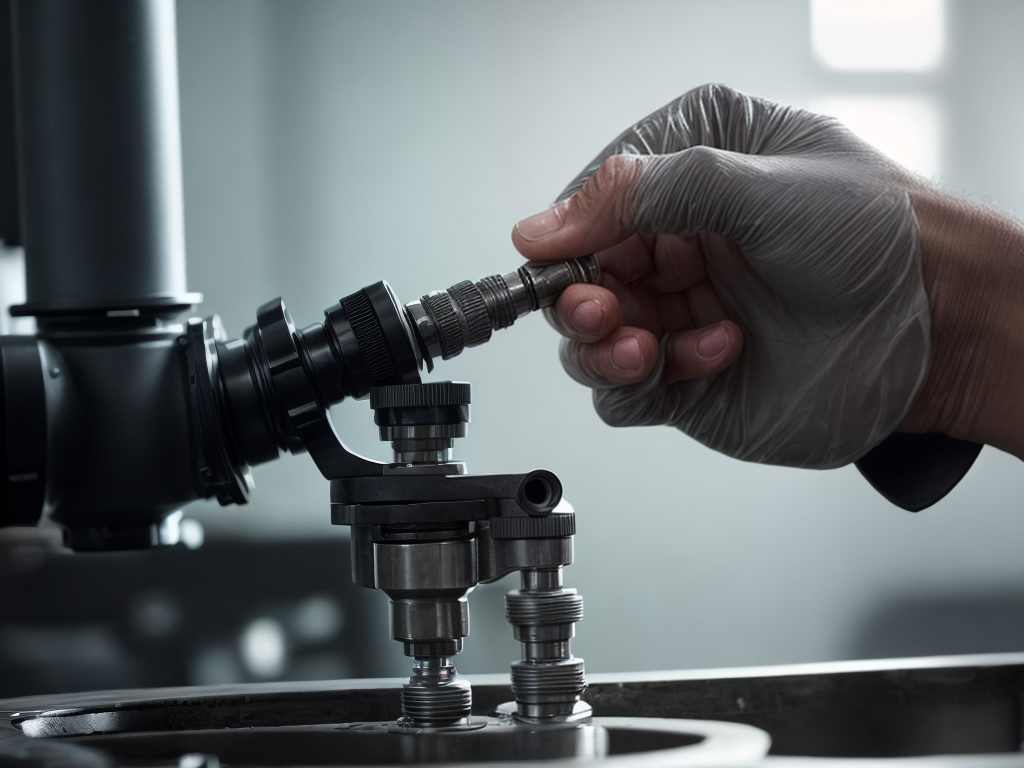
As an expert in the field of valve manufacturing, I am well aware of the crucial role that quality control plays in ensuring the reliability and performance of valves. Just like a hidden thread that holds together the intricate machinery of a watch, quality control is the invisible force that ensures the smooth operation of valves in various industries. From the design and material selection to the manufacturing process and testing methods, every step is meticulously scrutinized to meet the highest standards. But what exactly goes into ensuring the quality of valves? In this discussion, we will explore the intricacies of quality control in valve manufacturing, uncovering the key techniques and measures employed to ensure impeccable valve performance.
Importance of Quality Control
Quality control is crucial in valve manufacturing to ensure that only the highest standards are met. As an expert in the field, I understand the importance of quality control in every step of the manufacturing process. One key aspect of quality control is supplier evaluation. It is essential to carefully evaluate and choose reliable suppliers who can provide high-quality materials and components. By working with trusted suppliers, we can ensure that the valves we manufacture meet the highest standards.
Another vital aspect of quality control is root cause analysis. When issues or defects are identified, it is crucial to determine the underlying cause and address it effectively. This process involves conducting a thorough investigation to identify the root cause of the problem and implementing corrective actions to prevent its recurrence. By addressing the root cause, we can not only fix the immediate issue but also prevent similar problems from arising in the future.
In valve manufacturing, quality control plays a significant role in delivering reliable and efficient products to our customers. Our commitment to quality control ensures that every valve leaving our facility meets the highest standards of performance and durability. By carefully evaluating our suppliers and conducting root cause analysis, we can continuously improve our manufacturing processes and deliver valves that exceed customer expectations.
Design and Material Selection
When it comes to valve manufacturing quality control, design considerations and material selection play a crucial role. The design of a valve must take into account factors such as pressure, temperature, and flow rate, ensuring optimal performance and reliability. Material quality is equally important, as the chosen materials must possess the necessary strength, corrosion resistance, and durability to withstand the operating conditions and ensure long-term functionality of the valve.
Design Considerations
In the process of valve manufacturing, careful consideration must be given to the design and material selection. Design aesthetics play a crucial role in attracting customers and enhancing the overall appeal of the valve. A well-designed valve not only improves its functionality but also adds value to the final product. However, design considerations should not overshadow cost considerations. It is important to strike a balance between design aesthetics and cost-effectiveness. Choosing the right materials is also essential for the successful manufacturing of valves. Factors such as durability, corrosion resistance, and temperature resistance should be taken into account when selecting materials. By carefully considering design aesthetics and cost considerations, manufacturers can create valves that meet both functional and aesthetic requirements while keeping production costs in check.
Material Quality
To ensure the highest standards of manufacturing, I carefully consider the design and material selection for valve production. Material quality is of utmost importance in valve manufacturing as it directly impacts the performance and longevity of the product. Here are four key aspects that I focus on when evaluating material quality:
-
Material composition: I prioritize selecting materials with the right chemical composition to ensure strength, durability, and resistance to corrosion and wear.
-
Material testing: I conduct rigorous testing to verify the mechanical properties of the materials, such as strength, hardness, and ductility. This helps me ensure that the chosen materials meet the necessary standards.
-
Compatibility with operating conditions: I assess the compatibility of the materials with the specific operating conditions, such as temperature, pressure, and fluid type, to ensure optimal performance and reliability.
-
Supplier reliability: I work closely with trusted suppliers who provide high-quality materials consistently, ensuring that the valves I manufacture are made from reliable and reputable sources.
Manufacturing Process and Techniques
When it comes to manufacturing valves, precision machining techniques play a crucial role in ensuring the quality and functionality of the final product. By utilizing advanced machining methods, we can achieve tight tolerances and precise dimensions, resulting in valves that perform optimally. Additionally, comprehensive inspection methods are employed to detect any defects or flaws in the manufacturing process, guaranteeing that only high-quality valves are delivered to customers. Ultimately, our commitment to these manufacturing techniques and rigorous quality control measures ensures the conformity and reliability of our valve products.
Techniques for Precision Machining
Precision machining techniques play a crucial role in ensuring the quality and accuracy of valve manufacturing processes. To achieve precision machining, the use of CNC programming is essential. This computer-controlled process allows for highly accurate and repeatable machining operations, resulting in consistent valve dimensions and performance. Additionally, surface finishing techniques are employed to enhance the quality of the machined parts. These techniques, such as grinding, polishing, and lapping, ensure that the valve surfaces are smooth and free from imperfections that could affect their functionality. Furthermore, advanced measurement tools and equipment are utilized to verify the dimensional accuracy of the machined components. By employing these techniques, manufacturers can produce valves that meet the strict quality standards and performance requirements of various industries.
Inspection Methods for Defects
After ensuring the precision machining techniques are properly executed, the next step in valve manufacturing quality control is implementing effective inspection methods for detecting defects in the manufacturing process. Non-destructive testing (NDT) is commonly used to identify defects without causing harm to the valve. This method allows for thorough defect analysis while maintaining the integrity of the product. NDT techniques include visual inspection, liquid penetrant testing, magnetic particle inspection, ultrasonic testing, and radiographic testing. Each technique has its own advantages and limitations, making it important to choose the appropriate method based on the type of defect being investigated. By utilizing these inspection methods, manufacturers can ensure that valves meet the highest quality standards and provide reliable performance for their intended applications.
| Inspection Method | Advantages | Limitations |
|---|---|---|
| Visual Inspection | Quick and inexpensive | Limited to surface defects |
| Liquid Penetrant Testing | Effective for surface and subsurface defects | Requires careful cleaning and preparation |
| Magnetic Particle Inspection | Able to detect surface and near-surface defects | Limited to ferromagnetic materials |
Table 1: Comparison of Non-Destructive Testing (NDT) Methods
Ensuring Product Conformity
To ensure product conformity in valve manufacturing, careful attention must be given to the manufacturing process and techniques employed. Here are four important factors to consider in ensuring product conformity:
-
Product testing: Rigorous testing should be conducted at various stages of the manufacturing process to ensure that the valves meet the required quality standards. This includes testing for functionality, durability, and performance under different conditions.
-
Quality standards: Adhering to established quality standards is crucial in ensuring product conformity. This involves following industry-specific guidelines and regulations to maintain consistent quality throughout the manufacturing process.
-
Process control: Implementing effective process control measures helps in identifying and addressing any deviations or variations in the manufacturing process. This ensures that the valves produced meet the required specifications and quality standards.
-
Continuous improvement: Regularly reviewing and improving the manufacturing process and techniques is essential for maintaining and enhancing product conformity. This includes incorporating feedback from product testing, identifying areas for improvement, and implementing corrective actions.
Testing and Inspection Methods
By implementing rigorous testing and inspection methods, the quality of valve manufacturing can be ensured and maintained at the highest standards. Testing techniques play a crucial role in identifying any defects or flaws in valve components, ensuring that only products that meet the required specifications are released to the market. One common testing technique is hydrostatic testing, which involves subjecting valves to high-pressure water to check for leaks or structural weaknesses. This test helps verify the integrity and performance of the valves under normal operating conditions. Another important testing technique is the pneumatic test, which uses compressed air or gas to check for leaks and measure the valve’s response to pressure changes.
Inspection processes are equally important in maintaining the quality of valve manufacturing. Visual inspection is often the first step, where trained inspectors closely examine each valve for any visible defects, such as cracks, corrosion, or improper assembly. Non-destructive testing methods, such as ultrasonic testing and magnetic particle inspection, are also employed to detect internal defects that are not visible to the naked eye. These methods use advanced technology to analyze the material’s structure and identify any irregularities that could compromise the valve’s performance.
To ensure the accuracy and reliability of testing and inspection processes, it is essential to establish strict quality control protocols. This involves regular calibration of testing equipment, proper training of personnel, and adherence to standardized testing procedures. Additionally, statistical process control techniques can be used to monitor the variability of test results and identify any trends or patterns that could indicate potential issues in the manufacturing process. By continuously improving testing and inspection methods and staying up-to-date with industry advancements, valve manufacturers can maintain the highest quality standards and provide reliable products to their customers.
Quality Assurance Measures
Implementing robust quality assurance measures is essential in ensuring the highest standards of valve manufacturing. As an expert in the field, I understand the importance of maintaining quality throughout the entire production process. Here are four key measures that can significantly contribute to achieving excellence in valve manufacturing:
-
Supplier Management: Establishing strong relationships with reliable suppliers is crucial. This involves conducting comprehensive audits to evaluate their capabilities and track record. By selecting reputable suppliers and maintaining open lines of communication, we can ensure the consistent delivery of high-quality materials and components.
-
Quality Control Training: Investing in training programs for employees is essential to instill a culture of quality. By providing comprehensive training on quality control principles, we empower our staff to identify and address potential issues early on. This proactive approach helps prevent defects and ensures that every valve produced meets the highest standards.
-
Continuous Improvement Initiatives: Implementing a system of continuous improvement allows us to constantly refine our manufacturing processes. By regularly evaluating and analyzing data, we can identify areas for improvement and implement corrective actions. This iterative approach ensures that our manufacturing practices evolve to meet the ever-changing demands of the industry.
-
Documentation and Record-Keeping: Maintaining accurate and detailed documentation throughout the manufacturing process is vital. This includes recording specifications, test results, and any deviations or corrective actions taken. Having comprehensive records not only facilitates traceability but also enables us to identify trends and make informed decisions to enhance overall quality.
Addressing Common Quality Issues
Addressing common quality issues is a crucial aspect of ensuring excellence in valve manufacturing. Identifying the root cause of these issues and implementing appropriate corrective actions is essential to maintain high standards and meet customer expectations. Let’s take a closer look at some common quality issues in valve manufacturing and how they can be addressed:
| Common Quality Issues | Root Cause | Corrective Actions |
|---|---|---|
| Leakage | Defective seals | Improve seal material or design |
| Improper assembly | Implement stricter assembly procedures | |
| Damaged valve body | Enhance inspection and handling processes | |
| Dimensional | Inaccurate machining | Enhance machining processes |
| Inaccuracy | Implement precision measurement tools | |
| Improper tooling | Regularly maintain and calibrate tools | |
| Material Defects | Poor material quality | Source materials from trusted suppliers |
| Conduct thorough material inspections | ||
| Incorrect heat treatment | Follow proper heat treatment protocols | |
| Performance Issues | Improper valve | Conduct performance testing |
| design | Enhance design and engineering processes | |
| Ensure proper material selection |
Continuous Improvement in Valve Manufacturing
To ensure ongoing excellence in valve manufacturing, it is essential to focus on continuous improvement. By employing continuous improvement techniques and process optimization, manufacturers can enhance their production processes and deliver high-quality valves consistently. Here are four key strategies for achieving continuous improvement in valve manufacturing:
-
Implement Lean Manufacturing: Lean principles, such as reducing waste, streamlining processes, and empowering employees, can significantly improve efficiency and productivity in valve manufacturing. By eliminating non-value-added activities and optimizing workflows, manufacturers can achieve higher levels of quality and customer satisfaction.
-
Embrace Kaizen Philosophy: Kaizen, a Japanese term meaning “change for the better,” emphasizes continuous incremental improvements. Encouraging employees to identify and address small problems or inefficiencies in their daily work can lead to significant improvements over time. Regularly conducting Kaizen events and fostering a culture of continuous improvement can drive innovation and enhance overall valve manufacturing processes.
-
Utilize Six Sigma Methodology: Six Sigma is a data-driven approach aimed at reducing defects and process variations. By applying statistical analysis and problem-solving techniques, manufacturers can identify and eliminate root causes of quality issues. Implementing Six Sigma methodologies can result in improved process control, reduced costs, and enhanced customer satisfaction.
-
Foster a Culture of Learning and Innovation: Creating an environment that encourages learning, experimentation, and innovation is crucial for continuous improvement in valve manufacturing. Manufacturers should provide training opportunities, promote knowledge sharing among employees, and encourage the exploration of new technologies and techniques. By fostering a culture of learning and innovation, manufacturers can stay ahead of the competition and continuously improve their products and processes.
Incorporating these continuous improvement techniques and process optimization strategies can drive excellence and ensure that valve manufacturers deliver high-quality products consistently. By embracing a culture of continuous improvement, manufacturers can stay agile, adapt to changing customer demands, and achieve long-term success in the industry.


